Follow the Raptor Migration

Two Cooper’s Hawks over Pack Monadnock (photo © Chuck Carlson)
Biologists regularly record up to 15 different raptor species from platform at the Pack Monadnock Raptor Observatory. From mid-September through mid-October, significant daily and seasonal flights of Broad-winged Hawks, Sharp-shinned Hawks, Northern Goshawks, Peregrine Falcons, Ospreys, and Bald Eagles are possible. Mid-October through mid-November often brings Golden Eagles and Northern Goshawks.
During the migration season, detailed reports — including hourly raptor count and weather data, non-raptor observations, special notes, season totals, and next-day forecasts — are posted at the end of each day on hawkcount.org, an online database managed by the Hawk Migration Association of North America (HMANA). Historic migration data are also available via hawkcount.org, and you can find summaries of Pack Monadnock migration data from recent years here. Hawk Watch Coordinator Phil Brown also provides regular in-season updates below.
The Pack Monadnock Raptor Observatory is a project of the Harris Center for Conservation Education, in partnership with the State of New Hampshire Department of Natural and Cultural Resources, Division of Parks and Recreation. It was founded by New Hampshire Audubon.
Updates from the 2025 Season
The View from Late October
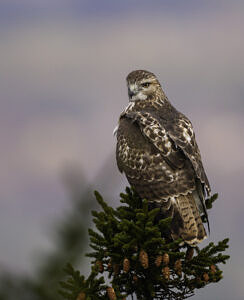
A juvenile Red-tailed Hawk, photographed at the Hawk Watch on October 24. (photo © Chuck Carlson)
October featured reduced but steady migration, including tallies of all fifteen raptor species recorded this season. The monthly count of around 1,000 individual raptors is typical, and several other species have now passed their peak seasons. Human visitors outpaced the raptors by a long shot, thanks to excellent fall foliage and great hiking weather! Harris Center educators greeted visiting school groups, along with many raptor enthusiasts who made their annual sojourns to the summit.
Rise of Black Vultures, and Hope for Harriers
Particularly notable this past month were four migrating Black Vultures (of six total this season, thus far) – which eclipses our past high count of two. This increase is part of a regional trend as this species expands its range further into the Northeast.
Northern Harriers, on the other hand, are a northerly breeding raptor with a particularly strong showing this season, on pace to break their past season-high tally. As in recent years, efforts to age and sex harriers have been successful at Pack; 80% of this year’s 120 harriers have been aged, with 75% identified as juveniles. While it’s difficult to discern any real population trends from one season at one hawk watch, these data may indicate a positive regional trend for this state-endangered species.
In addition to Black Vulture and Northern Harrier, American Kestrel, Sharp-shinned Hawk, and Cooper’s Hawk have also posted strong totals thus far this season.

On September 29, a spotted lanternfly alighted on Gina’s pole — one of the few records of this concerning forest pest in the Granite State thus far. (photo © Nate Marchessault)
It’s Not Just Raptors…
Our staff and volunteer crew tally more than just raptors. We also count migrating geese, loons, hummingbirds, nighthawks, and really, all species — even insects. Notable this season were a highlight — over 500 migrating monarch butterflies migrated past the Observatory between September and mid-October, a much higher count than in past years — and one lowlight: an invasive spotted lanternfly was photographed at the watch in late September, furnishing one of the few state records (thus far) of this new agricultural pest.
November Migrants
Looking ahead to late-season migration in November, Red-tailed and Red-shouldered Hawks will compete for airspace as they catch thermals on sunny days and ride the ridgeline following cold fronts. Additionally, prized species like American Goshawk and Golden Eagle – both already posting single-digit tallies – should continue and increase into November. Though migration slows as the season winds to an end, this time of year often features less-common visitors from the far north. A final late-season treat from the tundra may appear in the form of a Rough-legged Hawk, Short-eared Owl, or even a rare Snowy Owl. In addition to raptors, look for an increase in winter finches like crossbills and pine siskins as the season winds to an end.
Plan Ahead as Hours Change
Our final day of counting is slated for November 20, and when Daylight Savings Time comes to an end on November 2, our official observation hours will change from 9 a.m. to 3 p.m. The auto road will be open from 9 a.m. to 4 p.m. through November 11 — or whenever ice or snow accumulates on it. There’s one more chance for raptor-related community before all is said and done: come up to Pack on Saturday, November 8 to celebrate, share, or taste homemade soup as we host our annual “Big Soup” contest. This friendly soup contest starts at noon.
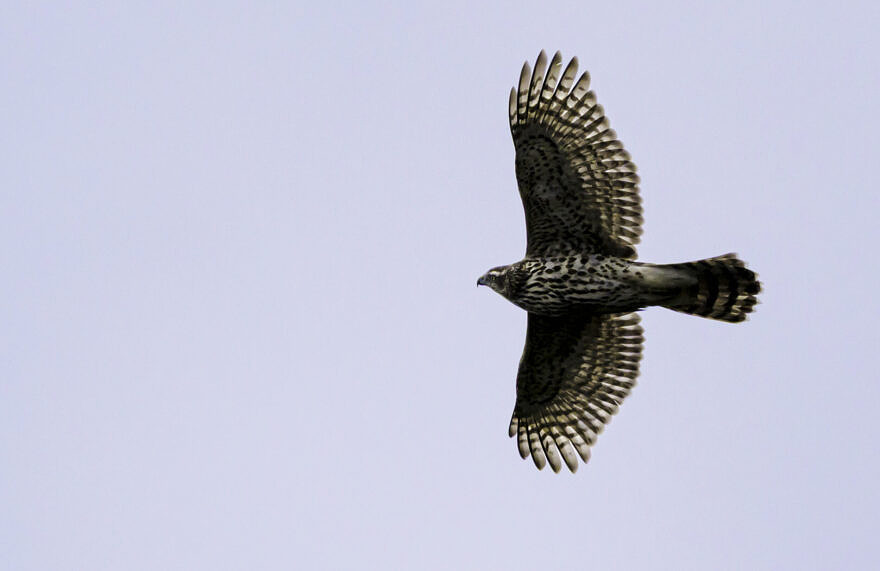
An American Goshawk wings past the Pack Monadnock Raptor Observatoryin late October. (photo © Chuck Carlson)
Broad-wings Lead the Way at Pack Monadnock
Nearly 200 onlookers celebrated International Hawk Migration Week with the Harris Center at the Pack Monadnock Raptor Observatory on Saturday. Under clear skies with a light northern breeze, binoculars pointed skyward as a steady migration took place overhead.
Broad-winged Hawks have led the way during this peak migration period in the Northeast, with the season’s tally already topping 6,800 birds. Some of the Harris Center’s own tagged Broad-wings are currently working their way south along the Appalachians. Smaller groups of Sharp-shinned Hawks, American Kestrels, Bald Eagles, and Ospreys followed, along with a few other species making appearances.
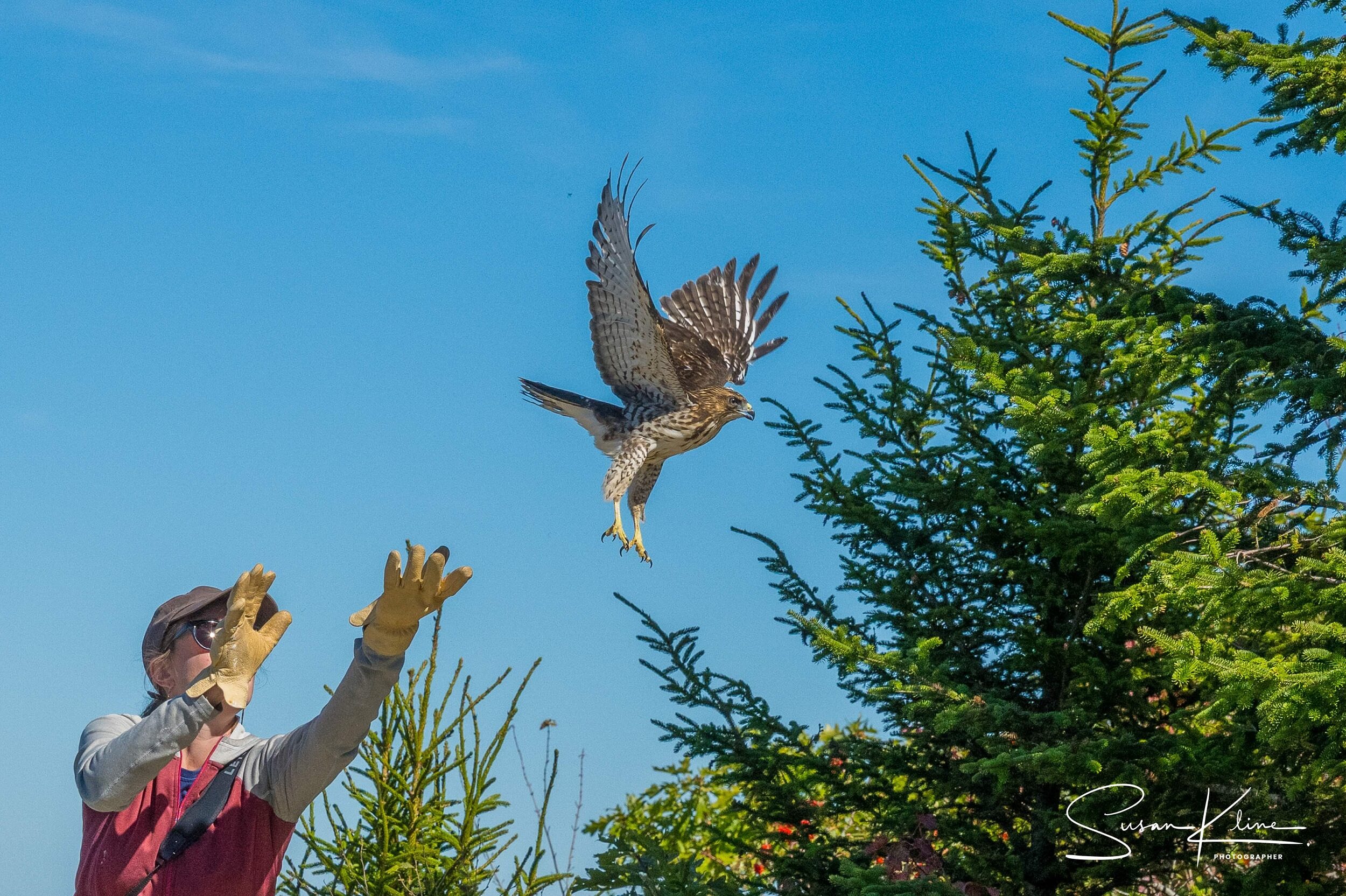
One of three rehabilitated Broad-winged Hawks released Saturday after recovering from rodenticide poisoning.
(photo © Susan Kline)
Another weekend highlight was the annual Raptor Release, when three rehabilitated Broad-winged Hawks — an adult and two juveniles — soared back into the sky before an enthusiastic crowd. These birds had been treated at Wings of the Dawn, a wildlife rehabilitation center in Henniker, New Hampshire, that partners with the Harris Center each year. One of the biggest threats to raptors is rodenticide (rat poison), which poses a serious challenge in the Granite State and well beyond. All three rehabilitated hawks had tested positive for rodenticide exposure. Safer alternatives exist, and efforts to ban these poisons deserve stronger support.
Although the peak of Broad-winged Hawk migration has passed, plenty of excitement remains, with many other species expected in larger numbers over the next two weeks. It’s a great time for hawk watching — and the fall foliage is looking beautiful too.
Stay tuned to hawkcount.org for daily reports from Pack Monadnock, and please be aware that reservations are strongly recommended to visit Miller State Park. You can visit the park’s website for more details. Happy hawk watching!
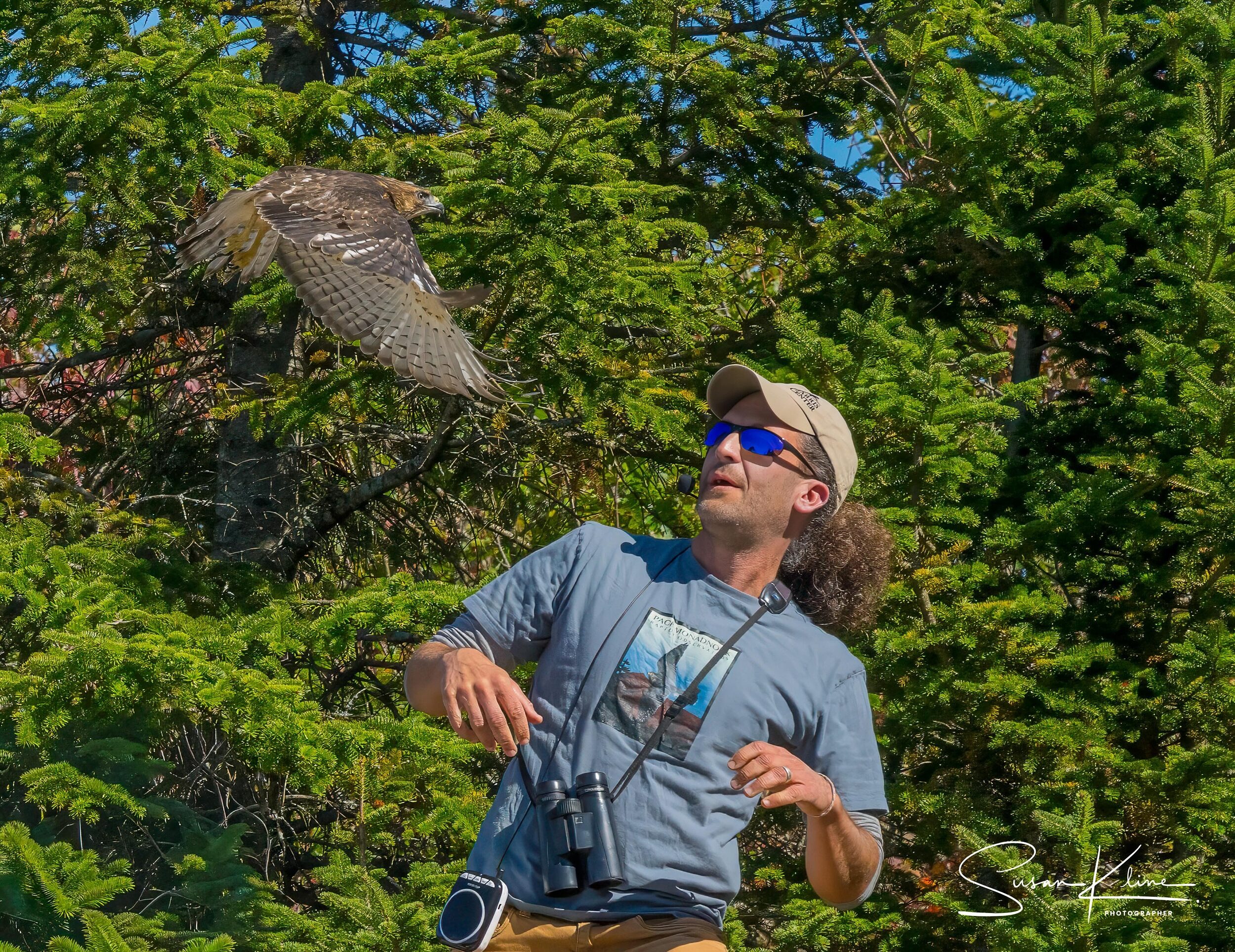
Our 21st Season Has Begun
Another season of hawk watching is upon us! Now entering its 21st consecutive year, the Pack Monadnock Raptor Observatory continues to thrive, thanks to support from the Harris Center, NH Parks, and all of our supporters.
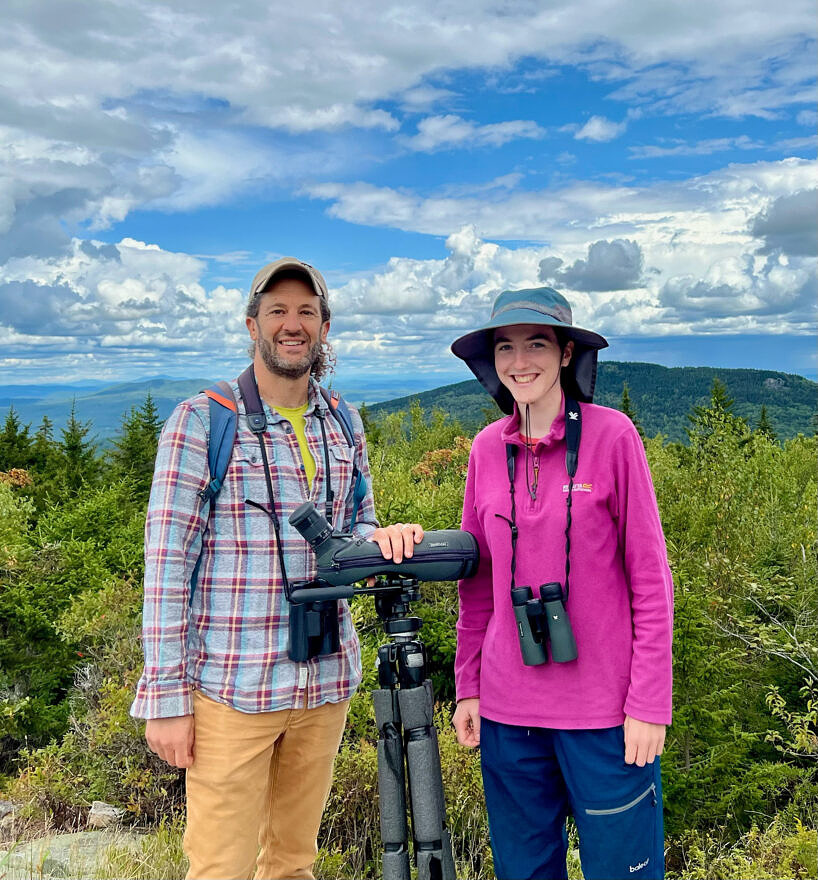
Bird Conservation Director Phil Brown & Raptor Biologist Kate McKay (photo © Glen Chretien)
Welcome Kate McKay
We’re excited to welcome Kate McKay as our new full-time raptor counter. Kate is no stranger to the Monadnock Region, having completed three separate internships for the Harris Center in recent years. Most recently, Kate was our wildlife intern, where she worked on conservation projects focused on the American Kestrel, Broad-winged Hawk, and American Goshawk. Kate hails from upstate New York and is a recent graduate of Cornell University, where she immersed herself in the study of the natural world, with particular interests in birds and dragonflies. She’s excited to meet our awesome community of raptor fans, spend time outside with birds, and be a welcoming face for the Hawk Watch’s many visitors.
Our 2025 Hawk Watch Team
This year, Harris Center ecologist Nate Marchessault will also be returning to the Hawk Watch on Mondays, stepping into founder and longtime volunteer Iain MacLeod’s big shoes. We hope to see Iain on the mountain from time to time. Julie and Phil Brown will again cover most Tuesdays. Harris Center teacher-naturalist Nikko Gagnon returns for a third season to help with interpretation and group visits on Thursdays from early September to mid-October. Glen Chretien, Tom Delaney, and Mark Timmerman plan to help us round out coverage, and we hope to see past counters, Katrina Fenton and Levi Burford, filling in and helping out as their schedules allow. What a team!
An Important Update on Auto Road Construction
Miller State Park is currently making planned improvements to its Auto Road and is only accepting day-use reservations for weekends until construction is complete. Please note that the road may be closed at times Monday through Friday while construction is taking place. Hiking to the Hawk Watch will remain an option during park hours. (See this page for more details about visiting the Observatory.)
Thank You and Stay Tuned!
As we launch our 21st season, we thank you — our sustaining donors, partners, supporters, volunteers, observers, and readers — for your ongoing support of the Pack Monadnock Raptor Observatory. Your help enables us to continue our important dual mission of educating the visiting public about raptors, while also contributing vital data to international raptor population monitoring efforts.
More updates and hawk-watching adventures are on the way. Keep your eyes on the sky, and stay tuned to this Field Reports page for regular news from atop Pack Monadnock.
Field Reports Coming Soon…
The Pack Monadnock Raptor Observatory is about to soar into its 21st consecutive season of raptor migration monitoring and education at Miller State Park. Stay tuned for migration updates, announcements of special events, and more!
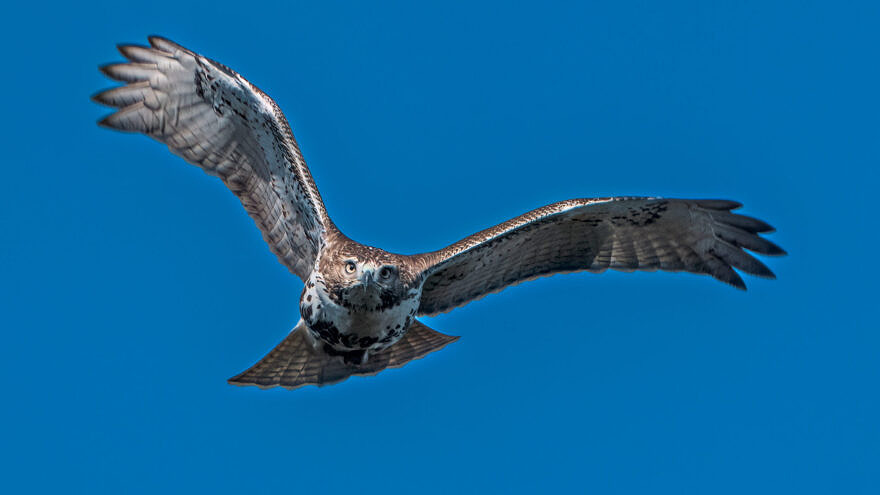
A juvenile Red-tailed Hawk flies past the Pack Monadnock Raptor Observatory, watching the hawk watchers who are watching him. (photo © Tom Momeyer)
Contact Us
For more information on the Pack Monadnock Raptor Observatory or to volunteer, please contact Bird Conservation Director Phil Brown.

